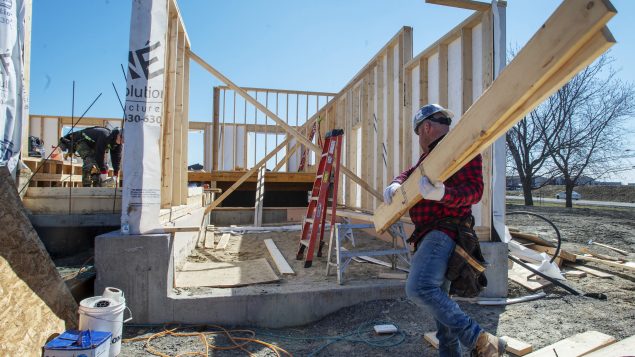Fueled by loosening pandemic restrictions and warmer weather, Canadian housing starts set an all time record by rising 21.6 per cent in March, data from the Canadian Mortgage and Housing Corporation showed on Monday.
The seasonally adjusted annualized rate of housing starts rose to 335,200 units in March, the CMHC data showed.
Shelly Kaushik, an economist with BMO Capital Markets, said the gain was much larger than expected and marks the strongest single month since data collection began in 1990.
Much of the gain was on multiple urban starts, which jumped 33.8 per cent to 222,358 units. Single-detached urban starts rose 3.6 per cent to 78,615 units.
“The big acceleration came as weather was unseasonably warm in many parts of the country,” Royce Mendes, senior economist at CIBC Economics, said in a note.
Mendes added that new home construction will likely be a major contributor to overall GDP growth again in 2021, even as building activity cools off from the “torrid pace” of recent months.
Kaushik said the increase in housing starts should also eventually help cool down Canada’s “red-hot” housing market.
Canada’s average home selling price jumped 31.6 per cent year over year in March, hitting a new high as sales also climbed to a new all-time record, the Canadian Real Estate Association said earlier this month.
Demand for detached homes in smaller cities has been supported by record-low interest rates and a preference for more space during the pandemic, Kaushik said. Still, the country’s largest cities are poised to lead the recovery as restrictions eventually ease, she added.
“Red-hot demand for real estate propelled a record month for housing starts in March. While the market will need a long stretch of supply growth to have a meaningful effect on prices, the March numbers are a solid start,” Kaushik wrote in an analysis note to clients.
Labour shortage looms in construction industry

Construction workers rig materials for a lift during the COVID-19 pandemic in Toronto on Tuesday, September 29, 2020. New research by the Conference Board of Canada suggests that 2020 and 2029, 131,000 workers are expected to retire from the residential labour force, while only 105,800 new workers will be drawn from local populations. (Nathan Denette/The Canadian Press)
A new study by the Conference Board of Canada released Monday found that low mortgage rates and robust population growth are creating strong demand in the residential construction sector.
“There’s no question that residential construction has recovered and maintains a positive long-term outlook,” said Robin Wiebe, a senior economist at the Conference Board of Canada.
“We estimate that housing starts trailed household formations over the past 10 years, generating a shortfall of 140,000 units.”
With immigration poised to surge in the next few years, household requirements should remain strong, Wiebe added.
However, the report also found that despite the positive outlook, Canada’s construction industry is grappling with several issues, including rising prices for lumber and a shortage of skilled tradespeople to fill needed jobs.
The skills shortage is particularly worrisome for the industry. Between 2020 and 2029, 131,000 workers are expected to retire from the residential labour force, while only 105,800 new workers will be drawn from local populations, the report said.
The industry will have to increasingly rely on non-traditional sources of construction labour, such as women, Indigenous people, and new Canadians, to fill an estimated shortfall of 45,200 positions, the report said.
“The good news for people employed in the residential construction industry is that we anticipate wages to rise by about three per cent annually between 2022 and 2025,” said Wiebe.
“For builders, they will need to navigate labour shortages and uncertain land supplies if they are to make a profit in the medium term. Some developers seem to be snapping up available land in anticipation of future shortages.”
With files from Reuters







For reasons beyond our control, and for an undetermined period of time, our comment section is now closed. However, our social networks remain open to your contributions.